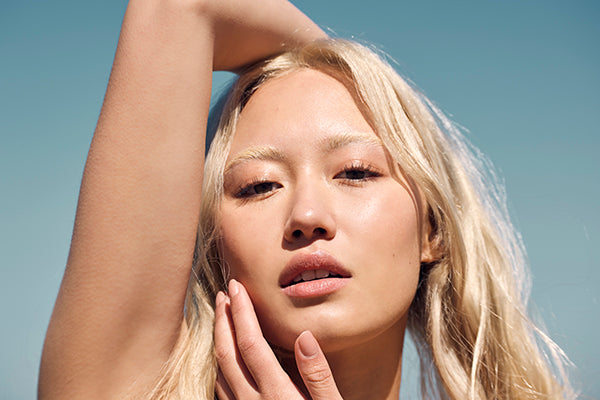Photoaging

Sun and Your Skin
Although we know that to age is a privilege, many of us would prefer to do so while protecting the condition of our skin. As sun damage is the number one cause of aging, read on to learn more about photoaging, and how it affects the condition of your skin, and how to best protect it from the harmful effects of the sun.
What is photoaging?
Commonly known as sun damage, the term photoaging refers to accelerated ageing of the skin caused by cumulative exposure to UV radiation. Photoaging accounts for around 80% of all aging of the skin and differs from chronological skin aging, which is pre-determined and known as intrinsic aging. Photoaging, falls under the category of extrinsic aging of the skin as it occurs through environmental factors.
How does UV prematurely age the skin?
There are two types of sun rays that are scientifically proven to damage the skin causing photoaging and lead to increased risk of skin cancer: UVA and UVB. The way in which they each cause damage to the skin differs however both are equally harmful. UVB rays have shorter wavelengths and are predominantly responsible for burning the surface of the skin, whereas UVA penetrates deeper. Cumulative exposure to both UVA and UVB rays causes damage to skin cell DNA.
When the sun’s rays reach the skin, cells within the skin respond by producing a pigment called melanin. This process causes the skin to darken and is a defensive mechanism of the skin in response to trauma. This increase in pigmentation (also known as tanning!), which is our skin’s natural defences when it’s trying to block potentially damaging UV from penetrating its lower layers. Cumulative sun exposure causes uneven tanning, also known as hyperpigmentation.
Exposure to UV also causes damage to the proteins that give skin structure, changing the way collagen and elastin are produced. This results in defective elastin and a loss of these supportive elements creating skin laxity. Over time and with repeated UV exposure, this depletion of healthy collagen and elastin manifests as sagging skin, uneven leathery texture and wrinkles.
What are the visible signs of photoaging?
Photoaging appears on parts of the body that are most vulnerable to prolonged exposure to the sun. The face, neck, decolletage and the backs of the hands are areas that fine lines, wrinkles, mottled hyperpigmentation, sunspots and textural changes are most common.
Photodamage also causes blood vessels in the dermal layer to dilate or break appearing as reddened flushed areas or spidery lines known as telangiectasia most common across the nose and cheeks.
Can photoaging be prevented?
The good news is yes. Photoaging is entirely preventable by avoiding unprotected sun exposure. When possible, avoid being out in the sun at peak times of the day when the UV index is highest. Wear protective clothing, sunglasses and invest in a broad brimmed hat if you are outside and always remember to apply SPF. Shop our range of everyday SPF products here
Antioxidants also play a large part in preventing and reducing skin damage caused by photoaging. Daily application of topical antioxidants helps to counteract UV induced oxidative stress in the skin. Vitamins C and E also have photo protectant properties, Vitamin E helps to protect the delicate lipid membranes of cells and Vitamin B has anti-inflammatory properties and assists in reducing the appearance of hyperpigmentation. Shop our antioxidant Vitamin Serums here .
Can the signs of photoaging be reversed?
Prevention is key when it comes to photoaging, as once the sun’s rays have caused cellular damage to our skins DNA it is not possible to completely reverse this which is why daily application of SPF is non-negotiable.
Improvement to the visible appearance of sun damaged skin is possible however with the use of accelerating acids. Ingredients such as Glycolic Acid work by encouraging the skin to shed top, pigmented and sun exposed layers of skin. This helps to minimise the appearance of fine lines, wrinkles, and uneven skin tone. Liquid Gold applied three alternate evenings a week is a good place to start for mature skins showing signs of photoaging.
Retinol is another important ingredient to help target the signs of photoaging. Retinol, a lipid soluble ingredient, can penetrate the surface of the skin and interact with receptors in the skin signalling them to kick start the production of collagen, supress hyperpigmentation and create new healthy skin cells. Vitamin A Serum with 0.5% Retinol is suitable for all skin types and is best applied alternate evenings to begin with.
- Tags: All Skin Science
